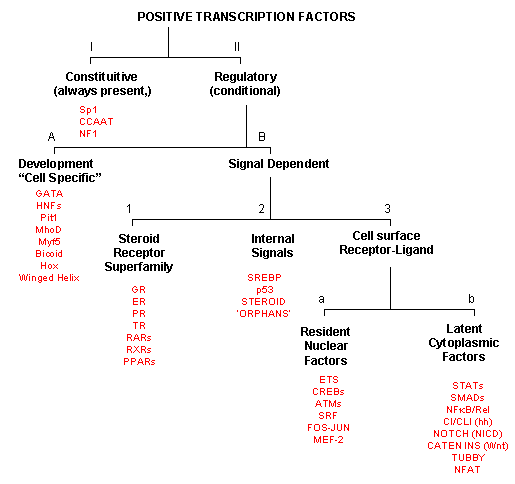Biochemistry Online: An Approach Based on Chemical Logic

CHAPTER 5 - BINDING
D: BINDING AND THE
CONTROL OF GENE
TRANSCRIPTION
BIOCHEMISTRY - DR. JAKUBOWSKI
Last Updated: 03/30/16
|
Learning Goals/Objectives for Chapter 5D: After class and this reading, students will be able to
|
D8. Classification of Transcription Factors
As inferred from above, transcription factors can be classified based on their protein structure. A newer classification scheme, based on the function/activity of the transcription factors, has been proposed by Brivan, Lou and Darnell (Science, 295, pg 813, 2002), as illustrated in the flowchart below, along with specific examples. The classes of transcription factors include those that are:
-
constitutively active : are always active in the nucleus of the cell and probably activate transcription of genes that must always be turned on;
The rest must be activated by some means, which include those that are:
-
developmental or cell type-specific whose genes must be transcribed (probably in a regulated fashion) to form the transcription factor which then enters the nucleus;
-
signal dependent transcription factors, which are activated through a signaling event.
There are classes of signal-dependent transcription factors that are activated by:
-
steroids, which are cholesterol derivatives that can pass through the cell membrane and bind steroid-specific transcription factors which turn on specific sets of genes; most of these transcription factors are present in the nucleus and are activated there by steroid hormones. One exception is the glucocorticoid receptor (GR) which is found in the cytoplasm;
-
internal signals derived from the cell, such as internally made lipid signals.
-
cell surface receptor-ligand interactions;
There are two types of receptor-ligand interactions that lead to transcription factor initiation.
-
small ligand molecules (like epinephrine) bind transmembrane receptors which leads to formation of second messengers or signals inside the cell, which ultimately activate Ser-phosphorylation activity. Nuclear transcription factors can become phosphorylated and activated.
-
small ligands bind transmembrane receptors which then bind to and activate latent transcription factors in the cytoplasm, which then migrate to the nucleus.
Figure: Transcription Factors: Functional Classification

Navigation
Return to Chapter 5D: Binding and the Control of Gene Transcription
Return to Biochemistry Online Table of Contents
Archived version of full Chapter 5D: Binding and the Control of Gene Transcription

Biochemistry Online by Henry Jakubowski is licensed under a Creative Commons Attribution-NonCommercial 4.0 International License.